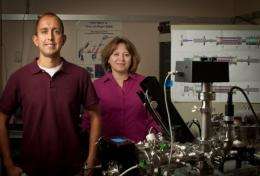Separating the Catalysts from the Chaff

When studying how specific catalysts drive reactions, scientists are often frustrated by the actions of unrelated molecules in the samples. Now, thanks to a device created by a team at Pacific Northwest National Laboratory, extraneous molecules are separated out of the samples and the desired catalyst is gently placed onto a surface. The team designed and constructed this soft-landing instrument after hearing about the challenges of separating catalysts from other impurities in heterogeneous samples.
"We can—for the first time—isolate single molecules and look at their reactivity when attached to a surface," said Dr. Julia Laskin, a physical chemist who led the effort with PNNL's Grant Johnson and Michael Lysonski, a student working at the Laboratory through the Science Undergraduate Laboratory Internship program.
Whether refining petroleum or building alternative fuels from carbon dioxide and sunlight, chemical manufacturing relies on catalysts. Making these reactions use less energy or produce more fuel means designing more efficient, affordable catalysts. To do this, scientists need to study the reactions without interference from other contaminants. With the soft-landing device, now available in EMSL, researchers can obtain pure samples and detailed information about a single catalytic species.
"This new device gives EMSL users a unique tool for studying catalysis," said Dr. Grant Johnson, a physical chemist at PNNL and one of the first Linus Pauling Distinguished Postdoctoral Fellows. "It's quick, efficient, and provides pure samples in vacuum, away from highly reactive oxygen and water."
The soft landing device prepares catalytic surfaces by separating out the desired molecule and gently depositing it onto a substrate. Then, the samples are transferred into a commercial time-of-flight secondary ion mass spectrometer (TOF-SIMS). The mass spectrometer allows scientists to determine the purity of the sample and to study its interactions with reactant gases.
"We've done soft landing of peptides, but this research is the first step for preparing catalysts with soft- and reactive landing and testing their reactivity," said Laskin.
How it really works: First, the sample is put into the gas phase using electrospray ionization. Then, the ions are focused through an ion funnel. The ion beam then passes through powerful oscillating electric fields that filter out the desired charged molecules.
Then, the pure beam of charged molecules is directed at the surface. The surface is then transferred into the TOF-SIMS. The TOF-SIMS enables detailed characterization of catalytic samples, providing data on compounds that were previously undetectable.
What's next? Laskin and Johnson are expanding the instrument's capabilities to give highly detailed, atomic-scale information about catalytic surfaces and interactions and to provide quantitative kinetic results. Their data will answer fundamental questions about catalysts and reactions that create fuels, chemicals, and countless other products.
More information: Johnson GE, M Lysonski, and J Laskin. 2010. "In Situ Reactivity and TOF SIMS Analysis of Surfaces Prepared by Soft and Reactive Landing of Mass Selected Ions." Analytical Chemistry 82(13):5718-5727. DOI:10.1021/ac100734g
Provided by Pacific Northwest National Laboratory


















